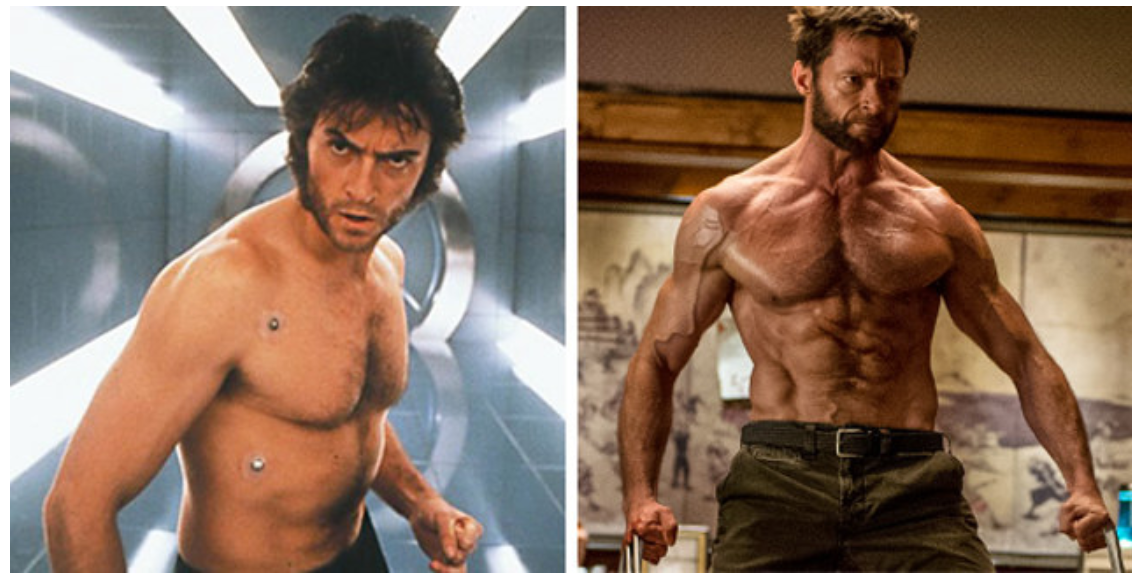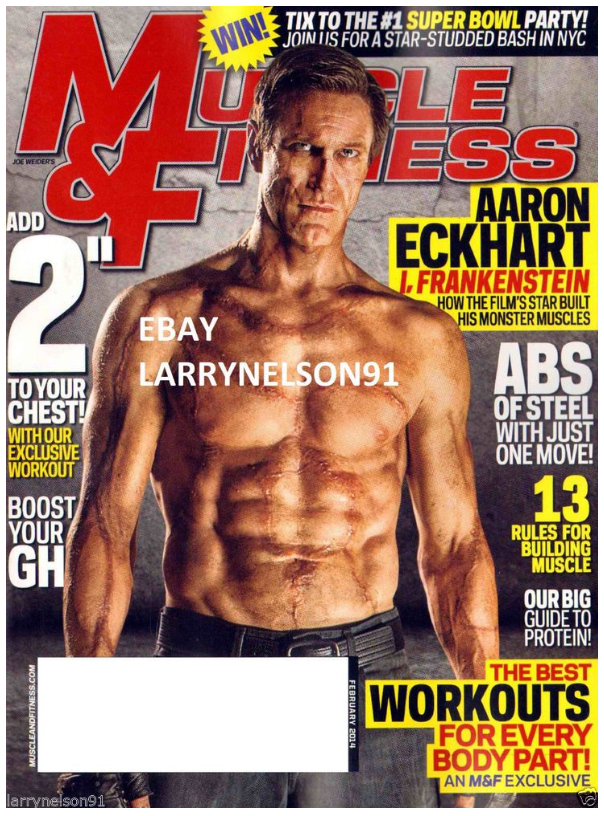When you’re buying your groceries, you can’t help but notice a men’s magazine cover story like, “Hugh Jackman’s Wolverine Body and How to Get It.” You flip idly through said issue while waiting in line, noting that the workout that produced Jackman’s striated, vascular musculature — a new cut that’s occurred well into middle age — consisted of 30 minutes of kettlebell swings, deadlifts and box jumps. Oh, and then there’s the diet: “Seventy percent of your physique is your diet, and diet is the biggest change that happens,” Jackman told the L.A. Times.

And it’s not just Jackman: Chris Evans, Chris Hemsworth, Henry Cavill, Christian Bale and even the formerly schlubby Chris Pratt have undergone extraordinary physical makeovers in preparation for roles as action heroes. Their shining examples tantalize us with the promise of deliverance through diet and exercise, but how many stars really reached these heights by merely putting less shitty food in their mouths and following a more focused (read: 30 minutes or less!) workout routine?

Rob McElhenney, describing his own body transformation during the last season of It’s Always Sunny in Philadelphia, made it abundantly clear just how difficult it is for the average person to get that coveted Hollywood body. “It’s not that hard,” he quipped on Instagram. “All you need to do is lift weights six days a week, stop drinking alcohol, don’t eat anything after 7 p.m., don’t eat any carbs or sugar at all, in fact just don’t eat anything you like, get the personal trainer from Magic Mike, sleep nine hours a night, run three miles a day and have a studio pay for the whole thing over a six to seven month span. I don’t know why everyone’s not doing this. It’s a super realistic lifestyle and an appropriate body image to compare oneself to.”
It wasn’t always like this. Once upon a time, directors either cast an established hardman — Charles Bronson, Lee Marvin, John Wayne, Sterling Hayden, Clint Eastwood — in the hero’s role, or looked outside the box for a superhuman powerhouse like Lou Ferrigno or Arnold Schwarzenegger. This split persisted well into the 1980s, with a clear distinction made between the conspicuously “beefcake” movies of Stallone and Schwarzenegger and more traditional action fare, featuring stars such as Tom Selleck, Kurt Russell and Harrison Ford.
The latter three were all reasonably fit — Selleck had played college basketball at the University of Southern California, and Russell was a decent minor league baseball player — but one heard relatively little about the “training routines” for the movies in which they starred. Pumping iron was the province of Schwarzenegger and Stallone; it certainly had nothing to do with Michael Keaton, who seemed content to portray the iconic Batman without making any significant changes to his Beetlejuice body (letting his Batsuit do all the work).
Today, of course, that would be unthinkable. Keaton, who at the time received a great deal of praise for his performance, would catch hell from viewers who believed he simply didn’t “look the part.” More than that, every semi-superheroic role now requires intensive physical conditioning, from Ben Affleck’s turn as a well-meaning goon in The Town (in which he debuted a totally reshaped body absent from his earlier, dadbod-in-spandex portrayal of blind crimefighter Daredevil), to Pratt’s repeated portrayals of the Marvel Cinematic Universe’s Star-Lord. Pratt, already one of the finer comedic actors of our generation, deserves praise for the “three or four hours a day of ass-kicking work” he did in the gym, but the added bulk seems wholly unnecessary for a space adventurer who rarely (if ever) appeared shirtless in the original comics and whose powers had far more to do with his ability to use a variety of high-tech weapons and deceive gullible enemies.
All of this is rather puzzling. “In an age of ostensible openness, we seem more confused about images and bodies than ever before,” says economist Ben Labe. “Men and women find themselves faced with an endless barrage of trompe-l’œil visuals for which proper explanations are rarely given. Oh sure, Lance Armstrong was constantly being ‘exposed’ as a performance-enhancing drug user, but he was also aggressively denying it. Actors and actresses frequently stay mum about their plastic surgery and liposuction, and the magazines that promote them and their products are only too willing to pass off such changes as the results of make-believe diets and fitness plans. At base, this is some kind of dance people are willing to engage in so that they can make more money. On top of everything else, a lie that’s widely accepted as truth or at least not questioned is the ultimate form of performance enhancement.”
Journalist Anthony Roberts, who has followed the fitness industry and its many steroid gurus and coaches for well over two decades, has watched as top actors have hired those gurus as trainers. “Obviously, aside from when someone’s name winds up caught in something like the Biogenesis or Iron Addicts stings, or gets caught red-handed with the drugs, as Sylvester Stallone was with HGH, you can’t just out-and-out say that this actor is a PED user without risking a defamation lawsuit,” says Roberts. “Is the Rock taking steroids? He denies it and there’s no conclusive proof, but he’s certainly in phenomenal shape for a 47-year-old man. What about John Cena, who brags about always passing his drug tests? There are plenty of ways to pass drug tests. In any case, the returns for steroid use in a field like acting, which doesn’t drug test its performers, are potentially quite significant.”
For Roberts, the 1999 movie adaptation of Fight Club was a seminal moment in action-hero body history. “Some time after Arnold and Stallone had their major franchises surpassed by the likes of Jason Bourne, it became a thing to be fit but not like a bodybuilder,” he says. “The linking groundwork there was probably Brad Pitt in Fight Club, where the lead was in great shape but didn’t necessarily have to be. Then eventually you saw the aesthetic changes. Bruce Willis’ Die Hard body was the only real alternative to the Arnold/Stallone body, and that morphed into what we have today with Daniel Craig and Chris Evans and the rest, which I think are a mix of Pitt’s Fight Club aesthetic with the Jason Bourne aesthetic of believability.”
Here’s what I wonder: Who would be harmed if someone like the Rock gave an interview and told the world that he had used HGH, that HGH was great and that other men in their 40s should consider using it, too? After all, he did admit to having breast reduction surgery in 2005 for “purely aesthetic reasons” (however, the surgery is often undertaken by steroid users who develop excess breast tissue due to poor post-steroid cycle therapy, to restart natural testosterone production and level off estrogen production). To be sure, he’d be pilloried in the press, much as Stallone briefly was following his arrest for importing HGH into Australia. Even when hard-hitting journalistic outlets like Entertainment Tonight tackle the problem of “steroids in Hollywood,” the actors they interview — like Pittsburgh’s hometown hero Joe Manganiello — claim on camera to be merely “working to achieve my natural capacity, what I was born with.”
But why? Why, in an era when we already know that every image and every performance we see is at least impacted by digital modification, should we forego having an honest and open dialogue about IRL body modification?
“I’m all for that kind of openness because it would be good for business,” says Brian Mehling, a New York-based orthopedic surgeon who runs a practice that provides patients with testosterone, stem cell and HGH treatments. “I’m not just a physician who prescribes and administers these treatments, I’m also my own patient and can attest to how well anti-aging medicine works. That said, I do understand the need for discretion that these celebrities have, since their images depend in part on the belief that they’re ageless genetic marvels with God-given, perfect bodies. There’s big money value in that.”
“However,” he continues, “that makes the legitimate medicine I do — from stem-cell treatments to HGH — a harder sell, because even people who aren’t involved in competitive athletics see it as taking the ‘easy road’ rather than just doing what smart, rich people choose to do. Everyone, however, would take the easy road if they knew no one else is looking, because that’s human nature. They want you to think they got there the hard way, but of course, they’ll take the easy road when presented to them.”
All things considered, isn’t letting all of us know we can simply pay to take the easy road preferable to believing some actor’s superhero body is a mere 30 kettlebell swings and 16 ounces of kale away from being yours? And to know, likewise, that hard bodies cost hard cash, and not being able to afford one is no great failing, just another sign of seemingly insoluble income inequality?
The truth about the performance-enhancing drug use of our idols and role models will set us free to respect and admire our own much less impressive, but less costly bodies, for their modest abilities as well as their considerable limitations.

